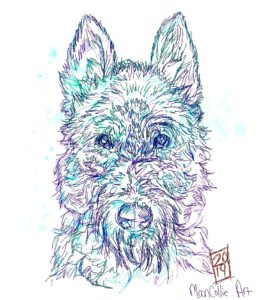
Properly Grooming the Belgian Laekenois
A breed that requires stripping! This is too much work!
Hold on a minute, let’s look at the reality of Laekenois Life Living with the Coat…
Laekenois have the advantage of having a coat that you control when the hair comes out and where the hair lands. The stripping of Laekenois coast is not an onerous task like many of the terriers or the working breeds that have complicated strip patterns, excessive timing steps, a battery of knives, rakes, stones and clippers. All used in combination to create a crisp, clean, polished, and sculpted look.
The Laekenois standard requires a tousled look and the techniques to get there are far less labor intensive and lack the precision required in other stripped breeds. A Laekenois should never appear sculpted and should never be scissored to achieve a sculpted look. The minute detail scissoring and clippering are not part of the Laekenois grooming method. Scissors are appropriate for trimming around the food pads for traction, the genitals and the bare underbelly that may have little matted areas.
Genetics play a roll in the Laekenois coat. Texture, length, amount of curl, color are all determined by genetics, as are black masks or the lack of a mask. If you look at enough Laekenois you will see variations in coat. There are excellent dogs under a variety of coats, and coat colors, which may be presented in various stages following stripping or not. The stage of coat at any given time must be understood. A Laekenois should be judged on the dog beneath the coat as well as taking into consideration the stage and quality of the coat.
The Laekenois is a bathe and go dog much of the time. Although bathing is not done frequently There are many Laekenois events where the dogs go from a working event, to a quick cool down in water and then move right on to the conformation ring without a huge amount of attention being paid to the coat.
Depending on the line your dog comes from the coat can vary from fairly tight to the skin and remaining so throughout the coat growth cycle to a thicker coat that some refer to as the Bouvieresque Coat that may require more work. In between these two extremes is the proper place to be at about 21/2 inches of length on the body. The Maintenance of the coat is a choice in so far as how much time you choose to put into it. A person exhibiting in the conformation show ring may be putting more time and planning into an individual’s Laekenois’ coat than a person who has their Laekenois strictly as a companion or competing in dog sports. In either care a weekly brushing is a bare minimum for maintenance.
The AKC Belgian Laekenois Breed standard describes the coat as follows:
Coat: The coat must have a texture which is rough and coarse giving a disorderly, tousled look. The coat should be severely penalized if silky or soft or lacking a double coat. The length of the hair should be approximately 2½ inches over the body. A beard must be present on the muzzle and hair on the head should not be in excess so as to hide the eyes nor the lines of the head and skull and make the head appear square or heavy. The tail should not form a plume.
The key items are:
- Rough and Coarse
- Disorderly Tousled
- 2½ inches over the body
- Beard must be present on the muzzle
- Head hair should not be in excess so as to hide the eyes nor the lines of the head and skull
- Tail should not form a plume
So the question many people considering the breed should ask is how do these aspects of the coat as described in the standard apply to my Laekenois Life? Have a look at the links below to understand the Laekenois coat more detail: